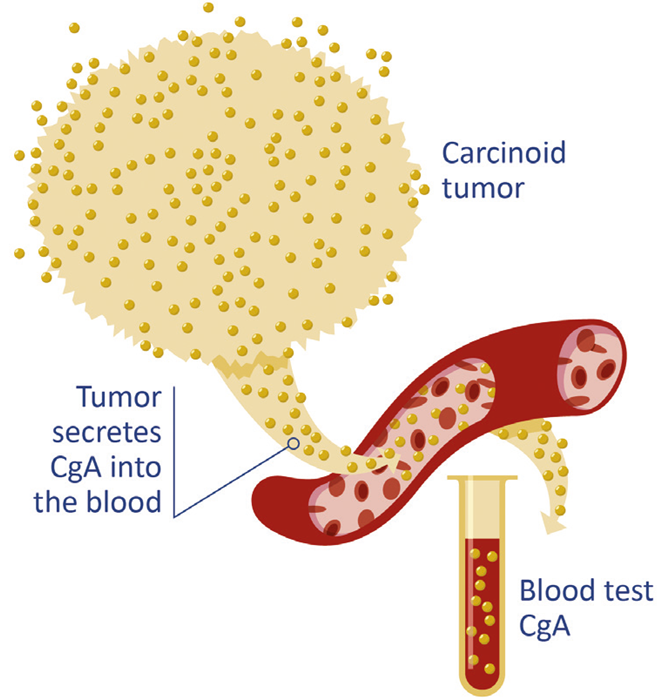The Chromogranin A ELISA demonstrates high specificity and sensitivity for various neuroendocrine tumors (NETs), thanks to monoclonal antibodies targeting the molecule’s central domain—specifically the unprocessed portion.
Chromogranin A origin and metabolism
Chromogranin A (CgA) is believed to function as a pro-hormone, with its proteolysis playing a central role in its physiological activity. This breakdown process releases various biologically active peptides—such as vasostatins, chromostatin, pancreastatin, and parastatin—which carry out distinct paracrine and autocrine functions. However, these peptides are not exclusive to NET patients.
The proteolysis of CgA is tissue-specific, with fragmentation patterns varying depending on the site of expression. This process primarily occurs within cells, inside chromaffin granules. In immunohistochemistry, the detection of CgA in tumor cells supports a neuroendocrine origin of the tumor.

Human CgA molecule sequence. Image Credit: IBL International GmbH, Part of Tecan group
Normal values measured with the Chromogranin A ELISA (30208352)
Circulating CgA is present in healthy individuals, with levels unaffected by age or gender. In a study using the Chromogranin A ELISA, 101 apparently healthy subjects showed serum values ranging from 23 to 101 ng/mL, with a median of 56 ng/mL (based on the 95th percentile range).
Clinical importance
Chromogranin A is considered the most reliable biomarker currently available for diagnosing neuroendocrine tumors (NETs), with proven clinical and prognostic relevance in conditions such as pheochromocytoma and carcinoid tumors. Measuring Chromogranin A is recommended as a diagnostic aid for patients with NETs—particularly gastroenteropancreatic neuroendocrine tumors (GEP-NETs)—when used alongside clinical assessment.
Chromogranin A ELISA
The CE IVDD Chromogranin A ELISA (Ordering Number: 30208352, distributed by Tecan, IBL International GmbH) utilizes monoclonal antibodies that specifically target the central region of the molecule (amino acids 145–245), corresponding to the unprocessed central domain. The assay is designed to detect both intact and fragmented forms of circulating CgA.
This design is key for:
- High precision < 10 % CV
- Excellent correlation with the previous gold standard CgA RIA and Random-Access devices
- High specificity for NET patients
- Consistent, reliable results: Standards based on human recombinant CgA.
Source: IBL International GmbH, Part of Tecan group
| PRODUCTS |
30208352
Chromogranin A ELISA |
Source: IBL International GmbH, Part of Tecan group
| RELATED PRODUCTS |
RE59395
TriCat (Adrenalin, Noradrenalin, Dopamine) ELISA |
RE59202
MetCombi Plasma ELISA |
RE59181
Metanephrine Urine ELISA |
RE59171
Normetanephrine Urine ELISA |

Image Credit: IBL International GmbH, Part of Tecan group
Inter-assay precision
Source: IBL International GmbH, Part of Tecan group
| Level |
Number of Samples |
Concentration ng/mL |
%CV |
| 1 |
34 |
81,6 |
6,43 |
| 2 |
36 |
122 |
4,68 |
| 3 |
31 |
182 |
4,13 |
| 4 |
35 |
407 |
3,19 |
| 5 |
36 |
445 |
3,98 |
| 6 |
35 |
632 |
4,73 |
Intra-assay precision
Source: IBL International GmbH, Part of Tecan group
| Level |
Number of Samples |
Concentration ng/mL |
%CV |
| 1 |
28 |
51,3 |
11,5 |
| 2 |
28 |
187 |
6,4 |
| 3 |
28 |
442 |
6,8 |
| 4 |
20 |
697 |
7,0 |
Automation
The Chromogranin A ELISA is a manual immunoassay and requires standard general-purpose laboratory equipment. It can also be easily adapted for use on open ELISA platforms, such as the Freedom Evolyzer®. However, the combined use of the assay, process script, and instrument must be validated individually by each laboratory on site.